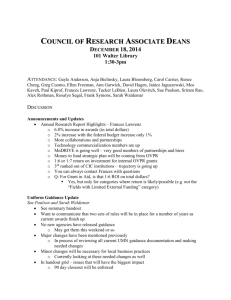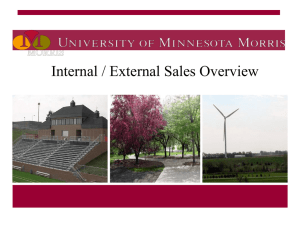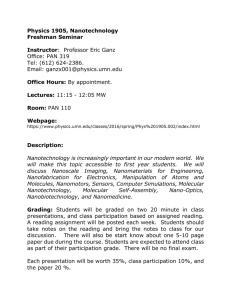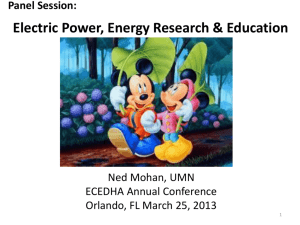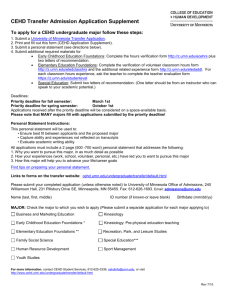MARW – Making Art in the Real World
advertisement
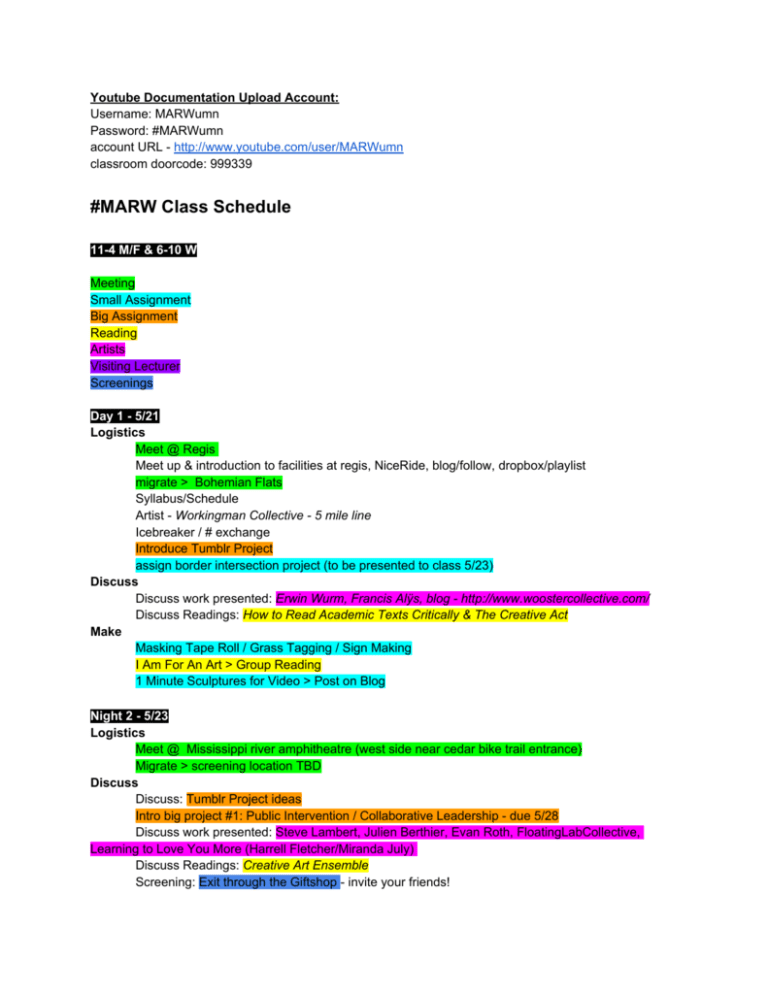
Youtube Documentation Upload Account: Username: MARWumn Password: #MARWumn account URL - http://www.youtube.com/user/MARWumn classroom doorcode: 999339 #MARW Class Schedule 11-4 M/F & 6-10 W Meeting Small Assignment Big Assignment Reading Artists Visiting Lecturer Screenings Day 1 - 5/21 Logistics Meet @ Regis Meet up & introduction to facilities at regis, NiceRide, blog/follow, dropbox/playlist migrate > Bohemian Flats Syllabus/Schedule Artist - Workingman Collective - 5 mile line Icebreaker / # exchange Introduce Tumblr Project assign border intersection project (to be presented to class 5/23) Discuss Discuss work presented: Erwin Wurm, Francis Alÿs, blog - http://www.woostercollective.com/ Discuss Readings: How to Read Academic Texts Critically & The Creative Act Make Masking Tape Roll / Grass Tagging / Sign Making I Am For An Art > Group Reading 1 Minute Sculptures for Video > Post on Blog Night 2 - 5/23 Logistics Meet @ Mississippi river amphitheatre (west side near cedar bike trail entrance) Migrate > screening location TBD Discuss Discuss: Tumblr Project ideas Intro big project #1: Public Intervention / Collaborative Leadership - due 5/28 Discuss work presented: Steve Lambert, Julien Berthier, Evan Roth, FloatingLabCollective, Learning to Love You More (Harrell Fletcher/Miranda July) Discuss Readings: Creative Art Ensemble Screening: Exit through the Giftshop - invite your friends! Make Performance For Photography: Border Intersections Day 3 - 5/25 Logistics Meet > MPLS Public Library Exterior 11am Migrate > inside MPLS Public Library 12:30-2pm Migrate > Coffee Shop Discuss Present Large Project Idea Performance/Archive/Cultural Material/Public-Private Space Discuss Readings: Dispersion & John C. Welchman Global Nets.... Discuss Works Presented: Young-Hae Chang, Cory Archangel, Daniel Eatock, Public Movement Assign Make An Encouraging Flyer Project Make Library/Archive as Material Made You Look - Public Performance/Intervention Day 4 - 5/28 Logistics Memorial Day (NO CLASS) Night 5 - 5/30 Logistics Meet @ Roving - based on Large Projects Migrate > TBD Discuss Review EVERYTHING done in class so far, projected, blog,vids, etc. Discuss Work Presented: John Ruben, Rirkrit Tiravanija, Conflict Kitchen (Jon Rubin), Lori Gordon, Piotr Szyhalski, Assaf Hasham Discuss Readings: Sure, Everyone Might be an Artist But... , Affectivist Manifesto Make Presentation / action for/of big project #1: Public Intervention / Collaborative Leadership Assign Big Project / Final Project #2 due 6/8 Day 6 - 6/1 Logistics Meet @ Regis center - Conference Room Migrate > Midway Library via downtown Discuss Find a relevant book in the midway collection, present to class project 2 written proposals/share Discuss Readings: Art Activism Reader: Democracy is a good idea: on politics, art ,and activism, idealism and pragmatism (pgs 90-94) Discuss Work Presented: Nikki S. Lee, Joseph Bueys, Roman Signer, Ana Mendieta, Tehching Hsieh, Michael Rakowitz, http://www.raumexperimente.net/ Make Distribute Encouraging Flyers Interview a stranger about the outfit they’re wearing (iPads) Day 7 - 6/4 Logistics Meet @ Boneshaker Books conf room 11am Migrate > Downtown Skyways Discuss dissect final project Visiting Lecturer: John Kim - Derive - Skyways Discuss Readings: Theory of the Derive (linked form blog) & Sadie Plant’s The Most Radical Gesture, pgs Preface, Chap 2 (Chap. 1 for more background info on Situationists) Discuss Work Presented: TBD by John Kim Make Derive Activity work on final project Night 8 - 6/6 Logistics Meet @ TBD by Guerilla Cinema Discuss Tumblr Reviews Discuss Readings: Holes In Our Pants Discuss Work Presented: GraffitiResearchLab, http://www.urban-projection.com/, the MAW Make Guerilla Cinema, location & Film TBD Invite your friends! Day 9 - 6/8 Wrapup Meet @ Walker Open Field (invite your friends) Course Evals Final Projects Due @ Walker Open Field makingartintherealworld@gmail.com pass - #MARWumn READINGS: Theory of the Derive, Guy Debord I am For an Art, Oldenberg BAD-ASS NEW CLASS radical democratic art FORMAT - Meet everywhere and anywhere; the best places for dialogue, project happenings, and events Meeting in places like: MPLS Public Library Coffeeshop Convention Center Weisman Museum Powderhorn Park Barbershop Artists & Examples Cory Archangel Lori Gordon Evan Roth Graffiti Research Lab Guests - Studio visits Piotr Szyhalski John Kim Activities: project for Northern Spark make a radio station street art/intervention flash mob going viral zines Public Performance Urban Architecture & Public Territories Links to review: http://publicmovementenglish.blogspot.com/ http://www.storefrontnews.org/exhibitions_events/events?t=318 http://archidose.blogspot.com/2009/04/ae13-inflatable-enclosures.html http://www.informationactivism.org/en/toolkitsandguides http://www.raumlabor.net/?cat=18 Lynn A series of questions that frame the weeks discussions course descriptions university policies section? remind kids how to find it list different class times must attend every class very active course description texts in-class reviews of tumblr blogs Too esoteric who’s our audience? use better language integrate theory into practice what do we want to teach context - summertime - students are going to want to leave. more practice based. social digital spaces how meaning is created physical vs digital community engagement - university push. natural cultural digital THEORY>DEVELOPMENT>EXECUTION Course Description: MAY TERM WORKSHOP PROPOSAL Form ARTS 5490 and ARTS 3490 Instructor’s name: Ben Moren and Daniel Dean (co-teach) Title of course: ○ The Enduring Ephemeral, or the Future Is a Memory ○ Social art in practice: looking at the less explored ○ Get Famous Quick: or how to use the Internet, and (explore?) other socially engaged artforms ○ social playgrounds, mobile playgrounds, digital playgrounds ○ breaking the rules, get arrested before lunch. ○ Microblogging Art ○ Facebooking and other ways to Make Art ○ Friending as Art ○ Friending as Art: Internet Thinking in the Real World ○ Using Social Collaboration & The Internet in Art Making ○ Democratic technology, using whats in your pocket and your community to make art. ○ in your pocket, in the cloud, in your community: alternative approaches to artmaking ○ ○ -----> #makingartintherealworld ○ ○ ○ ○ ○ Hashtagging the Real World: Making Democratic Art Today Democratic art in practice The Death of the White Cube: Where Art is Now The Internet and Democratic Art Making through social collaboration social collaboration: the internet and democratic art makingCourse level: Beginning, Intermediate Workshop ArtS 3490 Number of credits: 3 ( 3 credits = 15 contact hrs/week) Class meeting schedule: MWF, 11am - 4pm or 10-3 (ask about different meeting times for different days) List preferred classroom and required facilities: E123 REGIS, Laptops from Checkout insrurance issues/ diane List prerequisites if any: none Materials fee: $60 entrance fees OK artists talks - talk to Evonne 1/semester? 100$? Attach syllabus. The course description must include: 1. A Student Learning Outcomes f. Understand the role of creativity, innovation, discovery, and expression across disciplines g. Have acquired skills for effective citizenship and life-long learning. Through texts, presentations by visiting artists, illustrated lectures, and artistic practice, students will apprehend the conceptual framework of technologically focused, social art making and it’s relationship to the social commons, media, technology and cultural production. The proliferation of mobile technologies like laptops and cellphones, alongside the globalisation of corporations and the democratization of knowledge have allowed for the evolution of social practices in art. Participatory democratic actions, social media driven revolutions, flash-mobs, cultural memes, and remixing provide an immense field of practice for today’s artists. In a similar fashion to the way conceptual art expanded the field of art production in the 60’s and 70’s, the Internet and accessible technologies have further expanded the tools and methods by which artists can become cultural producers in a global arena. From techno-utopian visions to the hypermediation of culture, these ultra-accessible mediums have created an opposing desire for the creation of tangible relationships to your neighbor, your community, your food, and the social commons. Students will discuss their personal relationship to these ideas and explore how creative strategies can enhance their understanding and modify cultural ownership within existing power structures. 2. A paragraph describing how you will assess the students' learning related to this outcome. This class is a combination of lecture, discussion and studio practice. Students will be responsible for reading theoretical texts and discussing these texts together in class. Students will be expected to actively engage with these texts, lectures and the practices they describe by actively contributing via the Internet to social media sites, micro-blogging sites, and other online archives of media such as YouTube. Students will be immersed in a variety of technologies, upon which they will draw on technical skills learned in class to complete their conceptually founded projects. Students will work independently and collaboratively on projects that take form in public spaces and on the Internet, that are socially engaged, and interact with the public and the social commons. Students will be required to visit locations off campus that allow them to re-imagine where and the ways that art can engage the public. Syllabus Course and university Policies: Section 1 - Strategies: lectures and looking Day 1 - Re-Mix ○ Re-Mix Screenings ○ Appropriation, Sampling, & Mash-ups + Bourriard’s “Post-Production” Day 2 - Get Famous Quick (or how to use the Internet) ○ Social Media: twitter, facebook, blogs, forums ○ Memes: gifs, youtube, and the “I’m feeling lucky button” ○ Democratic Technology and accessibility ○ Personal Tagging: the # and the @ Day 3 - Subverting the System / Social Collaboration ○ Guerrilla Art / Architecture & Street Art ○ Public Intervention - HOTTEA ○ Social Engineering & Crowd Control: Flash mobs / robs ○ Radio / TV / News / Magazines / Flyers: public media outlets Section 2 - Mobile Playgrounds : testing and developing Day 1 - Mobile Technologies ○ Cell Phones / Cameras / Democratic Technology ○ Mobile Computing: Arduino & micro controlling / Electronics as accessibility ○ Mobile Sound / Projections / Light ○ On the Ground: MAW Day 2 - Public Space and Intermediate Territory ○ Corporate vs Public Ownership ○ The Social Commons and Government Structures ○ Urban Architecture & Public Territories ○ Public vs Private Space Day 3 - Democratizing & Sharing Knowledge ○ Wikis / copyleft / free software / opensource / linux revolution ○ personal file sharing / free access to the institution ○ alternative education models / free schools Section 3 - Social Art in Practice: Exploring the Less Explored Day 1 - Installation: In Between Territories and Placemaking ○ ○ ○ ○ Inflatables Public Sculpture Invisible ‘objects’ - Information / Measuring / Architecture/ Borders Subtle Installation & Im/Permanence Day 2 - Public Performance ○ Social Sculpture - Crowd Control ○ Public ‘Actions’ ○ Northern Spark - Mobile Projections / Sound ○ Amplification, one to many Day 3 - DIY & Documentation as the artform ○ Zines & Blogs: Analog & Digital Publication ○ Video Documentation ○ VVVVVVersions / re-mix and falsifying your own work ○ The Archive ***************************Entire Syllabi & Ideas********************************* Syllabus Course and university Policies: Section 1 - Strategies: lectures and looking Day 1 - Re-Mix ○ Media - Re-Mix Docu (http://films.onf.ca/rip-a-remix-manifesto/) ○ http://www.humanities024.com/?page_id=84 / http://newsreel.org/video/BLACKING-UP ○ http://learcenter.org/images/event_uploads/DemersNotes.pdf ○ appropriation - Sherry Levine, Rolling Stones, Bourriard’s “Post-Production” ○ http://www.jeanfrancoischarles.com/2011/11/beyonce-is-one.html ○ Sampling - Cory Archangel ○ mash-ups: Cubism & DangerMouse Day 2 - get famous quick (or how to use the Internet) ○ Social Media: twitter, facebook, blogs, forums ○ memes: gifs, youtube, and the “I’m feeling lucky button” - Evan Roth ○ Democratic Technology ○ Technology as accessability ○ personal tagging: the # and the @ Day 3 - subverting the system/collaboration ○ Guerrilla Art/Architecture & Street Art ○ Public Intervention / Stickers & Wheatpasting / Posters / Graffitti & Spray Chalk ○ Gaming the System ○ Social Engineering ○ Krowd Kontrol: Flash mobs / robs ○ Radio / TV / News / Magazines / Flyers: public media outlets Section 2 - Mobile Playgrounds: testing and developing Day 1 - Mobile Technologies ○ Cell Phones/cameras/democratic media outlet ○ ○ ○ ○ ○ ○ Mobile Computing Arduino & micro controlling / Electronics as accessability mobile projections/sound/power/light/ ipod orchestra http://www.madridabierto.com/en/artistical-interventions/2008/fernando-llanos.html megaphone - one to many amplification Documentation as work - the vehicle - preserving the ephemeral Day 2 - Public Space and Intermediate Territory ○ Corporate vs Public Ownership - Apple Store - Target ○ The Social Commons and Government Structures -9foot rule - bridge flag hanging - city hall - parks - occupywall. st ○ audience - passive and engaged Day 3 - Democratizing Knowledge ○ Wiki ○ copyleft / free software / opensource / linux revolution ○ aaaaarg.org / personal file sharing / free access to the institution ○ alternative education models / free schools - AJ warnick / free makers school / exsco ○ Ustream - LiveStream Section 3 - social art in practice: exploring the less explored Day 1 - Installation in the Intermediate Territory and Placemaking ○ Inflatables ○ Public Sculpture ○ Invisible ‘objects’ - Information/ Measuring / Architecture/ Borders ○ subtle installation & permanence Day 2 - Public Performance ○ Social Sculpture - Wurm / Endress / One-Minute Sculptures ○ Krowd Kontrol ○ Chalking on campus & in public ○ Mobile Projections Day 3 - DIY & Documentation as an artform ○ Zine - make one Analog & Digital Publication ○ Blog / Tumblr ○ Video Documentation ○ VVVVVVersions / re-mix and falsifying ○ Documentation as work - the vehicle - preserving the ephemeral ______________________________________________________________________________ 12/4/11 THEORY>DEVELOPMENT>EXECUTION>HOMEWORK ! TDEH Syllabus Course and university Policies: Section 1 - Re-Mix and Appropriation Day 1 - Theory: Discussion about Class Expectations (create manifesto?) ○ T: Re-Mix Docu, Have a discussion about sampling, remixing, and appropriation, show that this is common and part of every one's life today. Presentation of a few artists (yesmen, cory arcangel, ron english, kutiman, oliverlaric, daniel eatock, Mario Amaya) Exploitation (rolling stones, elvis), Blaxploitation, Cultural Theft/Colonialism, Dutch patterning in S.Africa, Robert Ruschenberg, TJ ○ D: Re-Mix your environment: urban landscape - signs and newspapers. Go out into the world collect items from your surroundings, create a re-mix, paper poems via redaction ○ E: Work on assignment, photoshop, cut and paste, photocopier, in pairs. ○ H: Reading: Bourriard/ Appropriation Book/ post examples of online appropriation and remix to class blog. ○ Introduce section 1 project: Find subject on Internet, re-photograph. make a set (3-5 photographs). Real Life and Internet Mashup/Re-Photography. Day 2 - Development: ○ T: Discussion of Readings ○ D: Discuss Project/Ideas for section 1 project ○ E: Social Media, create blog/tumblr and social media tools, logo/ identity design for class. this class as an appropriation of knowledge. ○ H: Finalize project ideas, gather any necessary materials for project (cameras, etc) complete if not performance based, ready for critique and discussion next class. Day 3 - Execution: ○ Show Section 1 Project(s) ○ Critique and theory discussion mashup. ○ Make Zines of everyone’s projects, distribute in newspaper boxes. Section 2 - Democratic technology, Social Structures and Collaboration Day 1 - Theory: ○ T: Discussion ~ Urban Screen Reader, Conversation Pieces (John Hester), Learning to Love You More (Harrell Fletcher/Miranda July), Rirkrit Tiravanija, Conflict Kitchen (Jon Rubin) ○ D: Culture jamming in-class project, pick a business type, go to that business (coffeeshop) ○ E: Create a place, be it online and in the world, generate collateral for that place, Yelp, fliers, Google maps etc., use the power of the class to leverage legitimacy - Barbershop? ○ H: Phonetograph (mobile phone photography) post to blog, reading Day 2 - Development: ○ T: John Ruben, center for the arts in society, Waffle Shop ○ D: Meet with business, find out what they need, make a commercial for YouTube, fliers, hand painted signage, Internet Promotion ○ E: Split into teams and begin making, talks about approaches and tactics ○ H: Continue daywork with a focus on web and external based project aspects. Social practice reading (short but relevant to this specific project) Day 3 - Execution: ○ T: ○ D: ○ E: Working with the business. develop any and all needs that they need met. ○ H: Photograph public spaces that your interested in exploring in the public spaces section. Reading (francis alÿs?) Section 3 - Everything is political: Public Space, Performance, Sculpture, Installation Day 1 - Theory: ○ T: Poetics of space (Gaston Bachelard), Joseph Bueys, Edgar Endress, francis alys ○ D: Highway signage, from protest, to campaigns, to the American flag. Breakout, small groups, develop concept collaboratively. ○ E: create and place the sign/object/idea/action in the real world, document. ○ H: Reading, Plan next meeting location collaboratively Day 2 - Development: ○ T: WHERE ARE WE GOING TO GO THIS DAY? ○ D: Public Performances, installations, and interventions, Document ○ E: Bring back to class, discuss ○ H: Reading Day 3 - Execution: ○ T: Finish All projects! ○ D: Blogs + documentation all finished and up to date. ○ E: University Evaluations ○ H: Course Wrap-Up/Discussion/Group hi-5 ■ how do you think about and understand art differently? *************************************New Final Thing***************************** Course Description: MAY TERM WORKSHOP PROPOSAL Form ARTS 5490 and ARTS 3490 Instructor’s name: Ben Moren and Daniel Dean (co-teach) Course Title: #makingartintherealworld Course level: Beginning, Intermediate Workshop ArtS 3490 Number of credits: 3 ( 3 credits = 15 contact hrs/week) Class meeting schedule: M/F-11am - 4pm, Lab - W-6-10pm List preferred classroom and required facilities: eStudio REGIS, Laptops from Checkout List prerequisites if any: none Materials fee: $20 1. A Student Learning Outcomes f. Understand the role of creativity, innovation, discovery, and expression across disciplines g. Have acquired skills for effective citizenship and life-long learning. In a similar fashion to the way conceptual art expanded the field of art production in the 60’s and 70’s, the Internet, and democratic technologies like cell phones and digital cameras have further expanded the tools and methods by which artists can become cultural producers in a global arena. From techno-utopian visions to the hyper-mediation of culture, these ultra-accessible mediums have created an opposing desire for the creation of tangible relationships to your neighbor, your community, your food, and the social commons. Students will discuss their personal relationship to these ideas and explore how creative strategies can enhance their understanding and modify cultural ownership within existing power structures. Through theoretical texts, presentations by visiting artists, illustrated lectures, and artistic practice, students will apprehend the conceptual framework of social art making and it’s relationship to the social commons, media, technology and cultural production. The democratization of knowledge and the Internet have allowed for the evolution of social practices in art. Participatory democratic actions, social media driven revolutions, flash-mobs, cultural memes, remixing, and appropriation provide an immense field of practice for today’s artists. Students will individually and collaboratively develop and make art projects. 2. A paragraph describing how you will assess the students' learning related to this outcome. This class is a combination of artists presentations, discussion, and studio practice. Students will be expected to actively engage with assigned texts and the practices they describe by actively contributing to in-class discussion and online. Students will be responsible for contributing media via the Internet to social media sites, micro-blogging sites, and other online archives of media such as YouTube. Students will be introduced to ways in which democratic technologies like cell phones and social media websites can be used to create or extend conceptually engaging artworks in the real world. Students will work independently and collaboratively on ephemeral projects that are socially or politically engaged. These projects may take the form of inflatable sculpture, public performances, hand painted signs, websites, online photo and video archives. Students will be required to visit locations off campus that allow them to re-imagine where and what ways art can engage audiences. (*We will meet off campus minimally ½ of the time.) 3. Course Description In this may term workshop we will explore the conceptual framework of social art making and it’s relationship to community, media, technology, and cultural production. The democratization of knowledge and the Internet have fostered the evolution of social practices in artmaking. Participatory democratic actions, social media driven revolutions, flash-mobs, cultural memes, remixing, and appropriation provide an immense field of practice for today’s artists. For 3 weeks we will actively engage in discussing and creating artworks, individually and collectively, that explore these new and exciting art opportunities. As we create, we will traverse Minneapolis’ urban landscape, drawing from and adding to our surroundings as a way to re-imagine where and what ways art can engage audiences. To do this we will meet off campus most class sessions. A bicycle or Nice Ride is strongly encouraged. #MARW Ben Moren - 612-327-7844 - moren151@umn.edu Daniel Dean - 202-306-5643 - leex5373@umn.edu Primary Meeting Location at Regis: eStudio/Room W206 Class Website: makingartintherealworld.wordpress.com Class YouTube account: user: MARWumn / Pass: #MARWumn Course Description In this may term workshop we will explore the conceptual framework of social art making and it’s relationship to community, media, technology, and cultural production. The democratization of knowledge and the Internet have fostered the evolution of social practices in artmaking. Participatory democratic actions, social media driven revolutions, flash-mobs, cultural memes, remixing, and appropriation provide an immense field of practice for today’s artists. For 3 weeks we will actively engage in discussing and creating artworks, individually and collectively, that explore these new and exciting art opportunities. As we create, we will traverse Minneapolis’ urban landscape, drawing from and adding to our surroundings as a way to re-imagine where and what ways art can engage audiences. To do this we will meet off campus most class sessions. A bicycle or Nice Ride is strongly encouraged. Course Objectives :: To develop a personal relationship to digital media and contemporary art by: 1. Introduce students to relevant artists and their participation and influence in contemporary culture 2. Students are expected to make good faith efforts at brainstorming, collective discussions and agreement and collaboration on in-class projects. 3. Experiencing, discussing, and critically writing/reflecting on socially engaged art, Internet art and strategies for merging the two. 4. Learning methods and criteria for evaluation and critique of contemporary art practices, as well as an awareness of global conversations and social issues 5. Conceptualization, development, and realization of art works that are responsive to the realities of the Internet, social media, and global and local relationships Some Thoughts on Learning :: Self-instruction is strongly encouraged as every aspect of what is covered in class is covered more widely and in more detail on the Interwebs and may also be gleaned in work sessions with your fellow humans. Curiosity, attention to detail and sharing of information that may assist colleagues is also strongly encouraged. We will learn from each other in this class and your instructor will work diligently to create an atmosphere amenable to these endeavors. Collaboration is an effective way to work quickly and experimentally with other human beings, practice this and remember that everyone can share ownership of a project and everyones ideas are legitimate, but allow for others to edit your contribution to an idea. This instructor does not advocate illegal activity such as the use of pirated software, copyright infringement, or unlawfully obtaining personal data. Similarly, this instructor encourages ethical behavior, particularly in relation to proper attribution of source material, plagiarism, etc. This instructor does advocate for experimental use of software, hardware, hacking, and using software, tools or resources in ways other than the maker intended. Participation: 1. All Projects are due completed at the beginning of class on due date. 2. The intention of this course is to produce art and to foster open conversations about art and ideas! There are no "DUMB" comments or questions. It is crucial to the intellectual and artistic atmosphere of the class that each student participate vocally and add to the knowledge pool of the class. Please feel free to engage more reserved classmates in discussions and to give others a chance to talk! 3. Though it is not expected that every student is an art major, it is expected that students explore ideas and process of making art. 4. Students are expected to draw conceptual relationships and connections between their art work and the ideas they are exploring in other art processes. Materials: ● ● ● Cellphone w camera/Smartphone Digital Point & Shoot Camera Bicycle *A Laptop or smartphone is Strongly Encouraged. Course Requirements: 1. On critique days noted on syllabus, each student must verbally present their work and thoughtfully discuss it in a critical context with classmates. 2. Students may be required to upload completed projects online to destinations directed by the instructor (e.g. Soundcloud, media mill, vimeo, etc.) and share the project link with the instructor via email, or as a link in your reflection on the project posted on the class blog . 3. Attendance, both mental and physical, and thoughtful participation in all aspects of class discussions and critiques 4. Completion of all assigned projects, reading and writings on respective due dates, this includes wany writings requested or contributions to online websites as assigned by your instructor 5. Be resourceful and share knowledge with your classmates 6. Be civil and curious because it’s human 7. Be thoughtful & respectful to others in this class - because we’re all learning here Communications: All out of class communications (eg... cancelled classes, meetings, announcements) will be done via the address you provide on the first day of class, you are responsible for checking this email, as well as other modes of class communication frequently (more than once per day). This will be the primary way to tell you what is going on, where we are meeting, and if there is a special circumstance that effects class. eg. rain, with a location change, class cancellations, etc. remember you are required to attend all classes ~ I didn’t know where I was supposed to go is not a valid excuse. Attendance: 1. You must attend all class sessions. Each day missed will equal one letter grade lost. ie. 1 missed class = drop from A to B (Due to the compressed nature of may term, realize that missing 1 class period is really like missing 3 classes during the regular semester.) 2. There are no unexcused absences (If you are seriously ill, or an family member dies, we will excuse you. (Documentation, documents, or proof is required for make-up credit opportunities) 3. Due to the mobile nature of this class, if you are tardy, you may not be able to catch up to the class. We will provide you with our phone numbers in case extenuating circumstances prevent you from meeting us at the appointed time/place. You must contact us! 4. no pain, no gain Grading breakdown: 50% projects 50% in-class work (discussions, in-class exercises, readings, etc.) University Grading Standards: A: Achievement that is outstanding relative to the level necessary to meet the course requirements. B: Achievement that is significantly above the level necessary to meet the course requirements. C: Achievement that meets the course requirements. D: achievement is worthy of credit even though it does not meet the course requirements. S: Achievement that is satisfactory and equivalent to a C- or higher. F/N: Represents failure (no credit) and signifies that the work was either (1) completed but at a level of achievement that was not worthy of credit or (2) was not completed and there was no agreement between the instructor and student that the student would be awarded an “I”. “I”: Incomplete – assigned at the discretion of the instructor when due to extra-ordinary circumstances, e.g. hospitalization, a student is prevented from completing the work on time. Requires a written agreement between the instructor and the student. For more details on the University Grading Policies, visit http://policy.umn.edu/Policies/Education/ Education/GRADINGTRANSCRIPTS.html Academic Dishonesty: Academic dishonesty for any portion of the academic work for a course shall be grounds for awarding a grade of F or N for the entire course. When another academic, creative or copyrighted work is used in whole or part of your artistic production, it must be noted to your instructor. Frequently Asked Questions pertaining to scholastic dishonesty: http://www1.umn.edu/oscai/integrity/ student/index.html. If you have additional questions, please clarify with your instructor for the course. Your instructor can respond to your specific questions regarding what would constitute scholastic dishonesty in the context of a particular class-e.g., whether collaboration on assignments is permitted, requirements and methods for citing sources, if electronic aids are permitted or prohibited during an exam. Student Conduct Code: http://www1.umn.edu/regents/policies/academic/Student_Conduct_Code.html) For additional information, please see:http://policy.umn.edu/Policies/Education/Education/ INSTRUCTORRESP.html. Student Conduct Code: The University seeks an environment that promotes academic achievement and integrity, that is protective of free inquiry, and that serves the educational mission of the University. Similarly, the University seeks a community that is free from violence, threats, and intimidation; that is respectful of the rights, opportunities, and welfare of students, faculty, staff, and guests of the University; and that does not threaten the physical or mental health or safety of members of the University community. As a student at the University you are expected adhere to Board of Regents Policy: Student Conduct Code. To review the Student Conduct Code, please see: http://www1.umn.edu/regents/policies/academic/ Student_Conduct_Code.html Disruptive Conduct: All activities in the University, including this course, are governed by the University of Minnesota Student Conduct Code. Students who engage in behavior that disrupts the learning environment for others may be subject to disciplinary action under the Code. In addition, students responsible for such behavior may be asked to cancel their registration (or have their registration cancelled). Credits and Workload Expectations: For the undergraduate courses, one credit is defined as equivalent to an average of three hours of learning effort per week (over a full semester) necessary for an average student to achieve an average grade in the course. Students taking a four credit Studio Art course that meets for 6 hours a week would expect to spend 12 hours per week outside of the classroom. For your own safety and that of others, do not prop doors or open the door for anyone after hours. Regis Center Info ~ BUILDING HOURS, SECURITY AND GENERAL POLICIES :: [+] The Department of Art’s Regis Center is open to undergraduate students Monday through Friday, 7 am to 11 pm and Saturday 7 am to 8 pm. The building is closed Sundays. A security monitor patrols the Regis Center from 11 pm to 2 am, Monday through Saturday. Undergrads needing to work beyond 11 pm must be in the building at 11 pm with a signed after-hours pass. At least 2 students must work together in the same area to obtain an after-hours pass. Undergrads are not allowed in the Regis Center after 2 am or on Sundays. The security monitor enforces this policy. Computer based things and Info: Connecting to Server In the finder menu bar > Go > Connect to Server > artserve.cla.umn. edu > affiliate1 NEVER WORK DIRECTLY OFF OF THE SERVER, ALWAYS DOWNLOAD FILES TO YOUR DESKTOP, THEN OPEN THEM. If you do not do this, there is a good chance the server will crash on you and you will lose all of your work. Art Department Equipment Checkout: https://secure.cla.umn.edu/checkout/art/index.php Theater Department equipment checkout/studio reservation: http://studios.cla.umn.edu/ Media Mill: http:// mediamill.cla.umn.edu/mediamill/ umn personal file, storage server: http://www1.umn.edu/adcs/guides/accounts/ filetransfer.html umn personal website guide: http://www1.umn.edu/adcs/help/webpage.html Equipment Checkout locations and online resources. *Doublecheck hours as they are subject to change as the semester gets underway Art Department Equipment: http://checkout.art.umn.edu Digital Service Bureau Printing: http://checkout.dsb.umn.edu CLA Rarig Equipment: https://claoit.umn.edu/checkout/studios/index.php Art Dept. Checkout – Hours & Rules Equipment Checkout: W139 Regis Art Center – 612.625.9532 Hours of Operation Monday – Thursday 9:00am – 9:45pm Friday: 9:00am – 5:45pm Saturday: 10:00am – 4:45pm Reservation Restrictions Checkouts must be at least 30 minutes long and no longer than 2 days. There must be at least 15 minutes between reservations for processing. Reservations can be submitted up to 2 weeks in advance. You can have at most 5 reservations scheduled per day and a maximum of 5 active reservations at a time. Items must be checked out within 1 hour of the scheduled pickup time or the reservation will be canceled. Users are limited to 1 camera per checkout. User Responsibility +Users are financially responsible for equipment that is lost, stolen, or damaged, while checked out in their name. Replacement or repair cost may be placed on the user’s student account. +Users are responsible for returning their equipment at their scheduled return time. Overdue Equipment Policy +Users who are habitually late returning equipment or return equipment more than 24 hours late may be banned from using equipment checkout. CLA Equipment Checkout at Rarig Center In addition to the video equipment available from the Art Dept, there are cameras and other equipment available from the College of Liberal Arts. The gear is located in CLA TV studios on the 5th floor of Rarig Center. Browse the available equipment and make reservations at https://claoit.umn.edu/checkout/studios/index.php Printing at the Digital Service Bureau (DSB) DSB Online Workstation Reservations checkout.dsb.umn.edu W 138 Regis Center for Art 612-626-4196 ****Hours of Operation There are currently NO office hours. Reservation Restrictions • User may book a piece of equipment up to 10 hours per week. • Reservations can be booked online up to 2 weeks in advance. • 15 minutes is required between reservations for processing. • Reservations can be made in 30min, 45min, and 1 hour slots, with up to 2 reservations back-to-back for small format or 3 for large format printers. • Users must be present within 10 minutes of their reservation time or their reservation will be canceled. User Responsibility • Users are responsible for finishing using the workstations at their scheduled reservation end time, this includes prints being completed by the printers. The larger the print the longer the printer takes to print it. • All prints will be paid for at the time of printing, either by a class fee (for students in photo classes) or pay-as-you-go. For pay-as-you-go the DSB technicians will supply students with a bill that must be paid at the photo crib before the prints can be taken from the DSB. The DSB makes every effort to make sure the equipment is running properly. If there is a problem please bring it to the attendant’s attention immediately. See our blog to answer all your questions and more: http://blog.lib.umn.edu/dsb/dsb/ Or contact your DSB team: 612-626-4196 dsb@umn.edu

